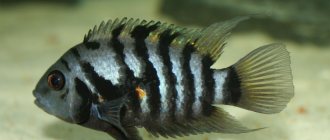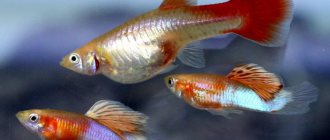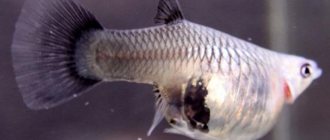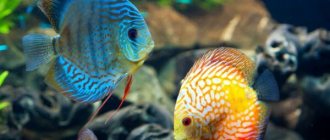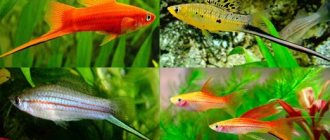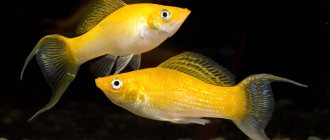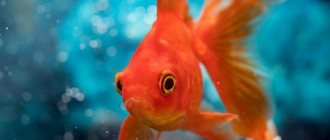Beautiful, capricious and even smart cichlids, representing the order of perciformes, will become a real decoration for a home artificial pond. In the aquarium they try to establish their own rules; it is very interesting to observe their behavior. In their natural habitat, they choose not only fresh but also salt water. The parental care of adults for the fry is especially curious; the parents will never hurt them.
Cichlids naturally live in both fresh and salt water.
Sex differences
Determining the sex of young cichlids is not an easy task. Only a few species of this family are characterized by distinctive coloring of females and males, while others do not have clear sexual characteristics. However, closer to the maturation of the reproductive organs, underwater pets of different sexes are increasingly different from each other.
Important! To inspect aquarium fish, it is recommended to handle them with wet hands, since dryness and a temperature of 36.6 °C can cause fatal burns for underwater inhabitants.
According to experienced aquarists, visual inspection is the most reliable method of searching for sexual differences in fish. But it is important to take into account that cichlids, due to their physiological characteristics, cannot stay without water for more than 30 seconds. And so that your actions do not cause them stress, it is advisable to repeat the short-term procedure several times.
In “boys”, between the anus and anal fin, a papilla protruding above the surface of the abdomen is clearly visualized. It is also noticeable if you run your finger along the corresponding fish side. And in “girls” the genital opening is characterized by a large diameter and the absence of protruding parts.
But this method is absolutely unacceptable for identifying representatives of the Neolamprologus species, since their females lay small eggs, which is why the genitals of both sexes are almost the same size.
Did you know? Among all the variety of aquarium fish, Astronotus ocellatus is considered the largest. Their body length is 35 cm
.
In addition, there are other, less effective ways to determine females and males. They are based on the following features:
- the size of the fish (often males are larger than females);
- features of their body shape (females have more rounded sides);
- the brightness of the color of the male (for example, the color of the males of the species Labidochromis yellow before spawning becomes more saturated than that of females);
- the presence of special pigmentation on the anal fins (in representatives of species whose females carry eggs in their mouths, there is at least one egg-shaped spot on the anal fin);
- the specific shape of the fins (in “boys” they are more pointed, and in “girls” they are characterized by rounded edges).
Types of fish
Cichlids are so numerous that it is impossible to describe them in a nutshell. Each individual deserves special attention. Some species are not at all capricious; even beginners can breed them. There are some individuals whose care requires enormous patience, attention and experience.
The most interesting and colorful aquarium cichlids are represented by the following fish:
- The blue dolphin is an inhabitant of African waters, externally reminiscent of the marine mammals of the same name; has a bluish color with a silver tint, one of the few that can be called peaceful and friendly.
Blue dolphin - a fish with a blue color and a silvery tint - Apistogramma cockatoo is a small fish with a bright red, orange or golden coloration with a large dorsal fin in the shape of a mottled crest; it grows to only 6−7 cm in length and is relatively aggressive.
- Discus is the most popular variety of cichlid to keep in an aquarium, growing up to 26 cm, and has a flat, disc-like body.
- Melanochromus aureus is an aggressive predator native to South Africa; it has a beautiful coloring - a golden body and black fins bordering it.
- Oscars are massive inhabitants of South American reservoirs and Asian rivers with a brick-red color and large rounded fins.
Other cichlids are also found. The views and descriptions of these individuals cause real delight among connoisseurs of aesthetics. But it’s not just their external beauty that attracts aquarium cichlids. Keeping them is a real pleasure, as they always behave actively and entertainingly even in artificial conditions. They can often be found digging the soil or digging up the roots of underwater vegetation. More aggressive individuals prefer to chase calm and quiet ones around the aquarium. Their life is always vibrant and attracts attention.
Preparation for reproduction
At the preparatory stage of cichlid breeding, the breeder must form a pair. But since methods for sexing spawners do not provide confidence in the accuracy of the choice, experienced fish farmers advise placing at least 5-6 individuals of each sex in one container.
After a short time of living together, the acquired fry will naturally form pairs. After observing the wards, the extra individuals are removed, leaving the strongest and most active ones for brood. Indeed, in the future, hostility and struggle will arise between the fish “families” for the safest areas of the artificial reservoir.
It is characteristic that at first many novice aquarists come to the conclusion that the cichlid community is sedentary and phlegmatic. But closer to the beginning of spawning, increasing conflicts between aquarium inhabitants radically change the prevailing opinion of breeders.
Important! External signs of cichlids indicate the imminent approach of spawning. Their color becomes brighter, and their fins straighten out more often and stand up at the same time.
In the process of forming a fish community of this family, experts advise paying attention to:
- features of fish behavior;
- their gastronomic preferences;
- requirements for water quality and conditions of detention;
- degree of aggressiveness.
If it is necessary to stimulate spawning, you should often change the aquarium water or heat it to 28 ° C.
For a larger offspring, the formed pair of fish can be placed in a separate spawning tank, the volume of which should not be less than 80 liters. But under no circumstances separate the mated female and male, because most cichlids differ from other brethren of the underwater world precisely in their monogamy.
For the convenience of residents, the artificial pond will need to be equipped with stones, driftwood, fragments of clay pots and coconut shells, as well as broad-leaved vegetation. These elements contribute to the reproduction of fish, because in cramped conditions of the aquarium it is difficult for them to find caves suitable for egg-laying.
Familiarize yourself with the species diversity of cichlids.
Conditions of detention
Before purchasing cichlids for keeping in an aquarium, you should familiarize yourself with the behavioral characteristics of different individuals. Not everyone can be housed in one container because of their lack of compatibility. In addition, some prefer plant foods, and some may eat other inhabitants neighboring them. The vast majority always aggressively defend their habitat, often taking the space of the entire aquarium as their personal territory.
General requirements of almost all representatives of cichlids:
- spacious, voluminous aquariums of at least 60 liters, large specimens prefer tanks of 300-400 liters;
Cichlids need spacious aquariums of at least 60 liters - water temperature - within 26−27 degrees;
- the aquarium must have caves, snags, grottoes, and a large number of stones;
- It is preferable to live in pairs.
Fish need regular water changes at least 2 times a week. An aeration system and filtering devices must be installed in the aquarium. The diet can be different: herbivores need chopped nettles, spinach, cucumbers, dandelions, lettuce and spirulina. The menu of predators should include squid, fish fillets, pieces of beef, live food, and shrimp. The couple may refuse food completely during the incubation period, which lasts 15-40 days.
Mating games
During this period, aquarium creatures become very active and funny. Their pre-spawning fun can last for hours, and sometimes for days.
The male tries to demonstrate his strength and weight in front of the female. This is manifested in constant fights in which he gets involved with the neighbors of the reservoir over territory, food and the attention of the female.
At the same time, the breeder can watch a real enchanting performance, which includes energetic movements, circular rotations, fin flutters and head signs. But the mating games don't end there. While playing around, the fish can move decorations, turn over the substrate, and is also able to completely clear the aquarium of fouling.
Important! Experienced aquarists advise feeding cichlids with protein foods during the mating season. This will improve the quality of the fry.
Feeding
Cichlid fish are not picky fish and there is no need to feed them anything special. They eat dry food well: daphnia, gammarus, as well as artificial industrially produced food. But it is always healthier to feed the fish not with “crumbs”, but with grated beef or pork heart.
Preparing such food is not at all difficult: the film of cartilage and fat is cut off from a frozen beef or pork heart, then cut into small pieces, placed in plastic bags and frozen in the freezer. If necessary, take it out of the refrigerator, grate it on a kitchen grater and feed it to the fish. For more information about feeding fish with beef heart, read the publication “food for fish, beef heart.”
Among the necessary and irreplaceable foods in the diet of cichlids there should be live food: bloodworms, coretra, daphnia, tubifex. If it is not possible to get such food, then you can feed the fish with small or chopped earthworms. How to properly cut an earthworm, read the publication “Food for fish earthworms”.
Spawning
In cichlids, the species of which lay eggs in the substrate, the spawning pair is inseparable. First, the female swims, laying eggs, and behind her is the fertilizing male. After this, the fish take care of their eggs, paying special attention to poorly adhesive eggs. In such cases, they have to regularly hill up the rows with future offspring, preventing them from scattering.
In those members of the family that incubate eggs in their mouths, such as blackstripes, spawning occurs differently. The female always takes a T-shaped position in relation to the male and, after laying several eggs, immediately captures them in the oral cavity.
Then, focusing on the peculiar pigmentation on the anal fins of the partner, she fertilizes the eggs. After a decline in spawning activity, the fish swims to a secluded place in the reservoir for further development of eggs.
Most cichlid pairs have fry within 3 weeks of spawning. But some species, such as Malawi and Tanganyika, require about 1 month to incubate. At the same time, the pets do not eat anything and noticeably lose weight. Ichthyologists advise completely limiting their feeding so as not to provoke cannibalism.
Did you know? The largest cylindrical aquarium in the world is located
in the lobby of the Radisson SAS Hotel in Berlin.
The capacity of 900 thousand liters has a height of 25 m. The aquarium is home to about 56 species of fish, the school of which reaches 2600 individuals. An interesting feature of the structure is an elevator with a two-story cabin, which is located inside a cylinder. Reproduction of cichlids: video
Biological characteristics
There are about one and a half thousand different species of fish in the cichlid family. They have a beautiful, bright oval body, the length of which can vary from 3 to 90 cm. The wide mouth has roller-shaped teeth, the lip line is well defined. A male can be distinguished from a female during puberty by the fatty growth that grows on the forehead. In nature, as in the aquarium, representatives of the cichlid family are monogamous. Having chosen a partner, they no longer change him throughout their lives.
Different types of cichlids can reach lengths from 3 to 90cm
With proper maintenance and care, cichlids can live for quite a long time. Their natural habitat is South America, Africa, and the Amazon River. Man has accustomed fish to artificial conditions, so the following individuals can often be seen in aquariums:
- discus;
- angelfish;
- melanochromus;
- Oscars;
- chromis;
- cichlazomas.
All individuals differ in body size and shape, behavior and coloring. Among them there are those that feed on food of plant origin, and there are also real predators. Often the hunt begins for the neighbors living in the aquarium.
How to avoid diseases
When buying cichlid fish, you need to know what this species is. About preferences in: nutrition, compatibility with other fish, temperature, as well as water hardness and acidity. If you have a rare and expensive specimen, for example, discus fish that love perfectly clean water, then it is better to keep such fish in a separate aquarium.
As we already know, most diseases are directly related to the immune system, which in turn is influenced by quality nutrition. The conclusion is this: if cichlid fish do not receive live food for a long time, which actually contains the essential amino acids necessary for the body, the health of those fish that are fed at least occasionally with live food will be significantly lower.
Notes: it should be noted that we are not talking about free feeding here, but only about feeding. I feed my fish with Daphnia moina. I feed little by little: in the morning at lunch and in the evening. The benefits of such feeding are obvious: the fish never show signs of dystrophy, they quickly grow in height, are always vigorous and cheerful, and their fins are clean and straightened.
I use Daphnia moinea to feed fry and recently purchased fish that are still in quarantine. Live food acts like a calming pill on new fish. Daphnia relieves stress because hardly any fish can resist moina. You can order Daphnia moina for home breeding on the “Food for Daphnia fish” page.
Food for juvenile fry
Grown fry should also be switched to larger live food. Such complete food can be: small bloodworms, chopped coretra, tubifex and daphnia.
Notes: sometimes it is not easy for aquarists to find live food for grown-up juveniles, and it is at this time that the nutrition of adolescents should be especially nutritious, otherwise the fish will begin to lag in growth and in the future they will no longer be able to catch up with their peers. What to do? The way out is simple!
Daphnia moina can be classified as a universal food and, if nauplis moina is well suited as a starter food, then grown-up crustaceans can also be fed to grown-up fry. Also, adult small cichlid fish, such as parrot cichlid fish, readily eat moin.
The nutritional value of Daphnia moin is not comparable to other species of Daphnia. Moin is easy to breed at home and such food can rightfully be considered a godsend for aquarists and fish breeders. You can order breeding of Daphnia moin for home breeding from my publication “Food for Daphnia fish”.
There are a huge number of species of cichlids, but among aquarists only some cichlid fish have gained the greatest fame and popularity.
Cichlid diseases
Cichlid fish are quite strong, but improper maintenance can lead to diseases. Even in a reasonably stocked aquarium with clean water and complete quarantine control, an outbreak of diseases cannot be avoided, the cause of which may be poor nutrition and non-compliance with the temperature regime (in this case, hypothermia).
The most common disease is ichthyophthyriosis (fish louse). Accompanied by compression of the fins and scratching of the fish on the ground. The body and fins are covered with a white coating in the form of small grains (semolina). The causative agent of the disease is an equiciliated ciliate parasitizing on the body of fish. Parasitic ciliates can be present in almost any aquarium, but they usually affect fish with a weak immune system.
Another common disease caused by improper fish keeping can be saprolegniosis. A fungus appears on the affected area, which resembles a stuck piece of cotton wool. All sick fish must urgently undergo treatment until complete recovery. You can learn how to cure sick fish from the publication “Treatment of aquarium fish with bicillin.”
Compatibility
Typically, cichlid fish are aggressive only during the breeding season. At this time, they establish their territory, which is strictly prohibited for outsiders to enter. Naturally, the living area of the neighbors will be somewhat reduced, which can cause inconvenience for the entire population of the aquarium, so it is advisable to keep cichlids in spacious aquariums.
Note: It is not wise to keep several male parrot cichlids in one tank. The aquarium can be quite large and spacious, but only one male will take the lead and will chase the rest of the males and force them to hide in the thickets of plants.
Angelfish and parrots, as well as other calm and small cichlid fish, are well suited for living together: swordtails, mollies, platies, gourami, zebrafish, catfish, cockroaches, corydoras and other peaceful species with similar temperature preferences.
Some species of famous cichlids
It is known that all selective species of discus are bred only from brown and blue discus. All color variations that exist today are derived from blue and brown and belong to the same species.
Brown discus - S. a. axelrodi. Amazon river. Grows up to 20 cm. Spawning tank: 80×40x40, dH 4°, pH 6.5, t 29° C. Quantity. caviar up to 400 pcs.
Green discus - Symphysodon aequifasciata, aequifasciata (object of selection). Homeland of Peru. Grows up to 30 cm. Spawning tank: 120×45x45, dH 2°, pH 6.5, t 29° C. Quantity. eggs from 250 to 500 pcs.
Blue discus - S. a. Haraldi. Amazon river. Grows up to 20 cm. Spawning tank: 80×40x40, dH 4°, pH 6.5, t 29° C. Quantity. caviar up to 400 pcs.
